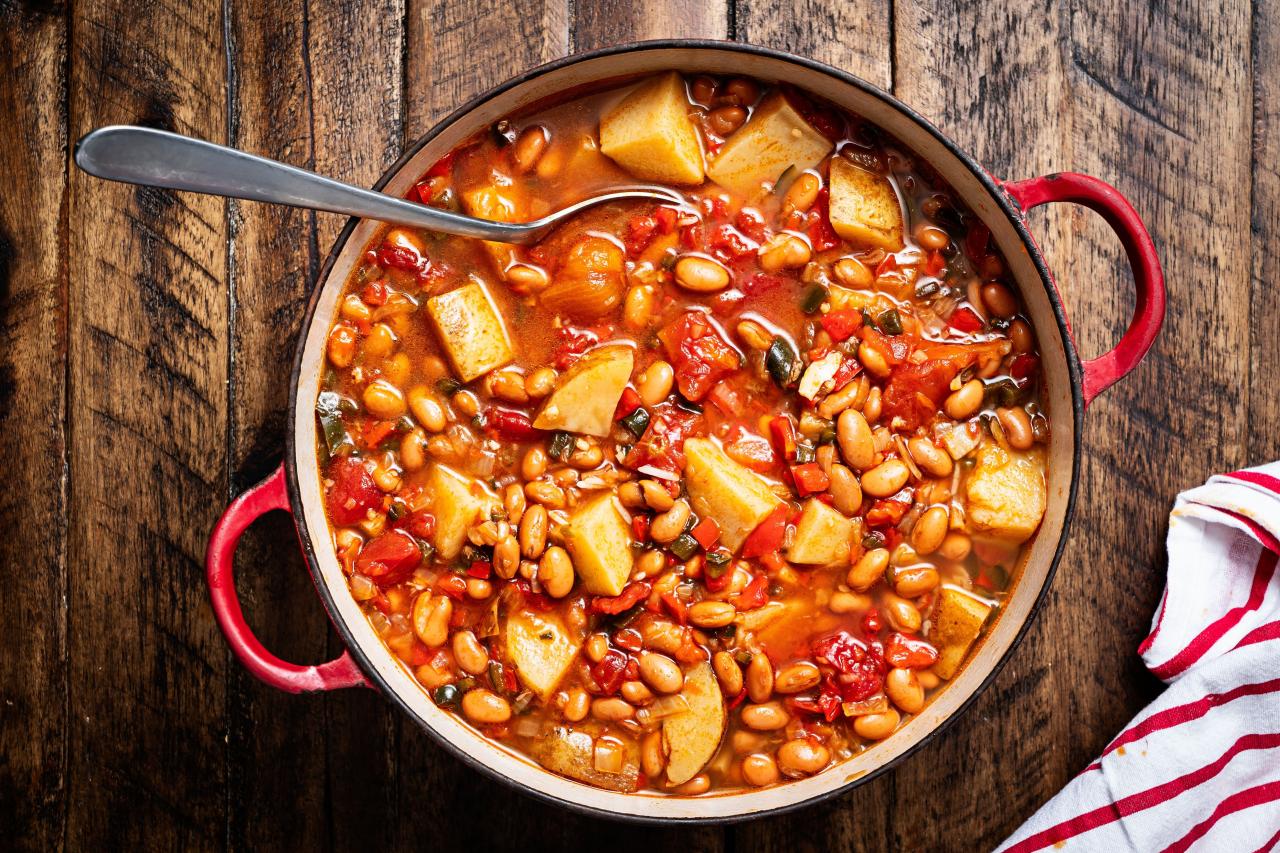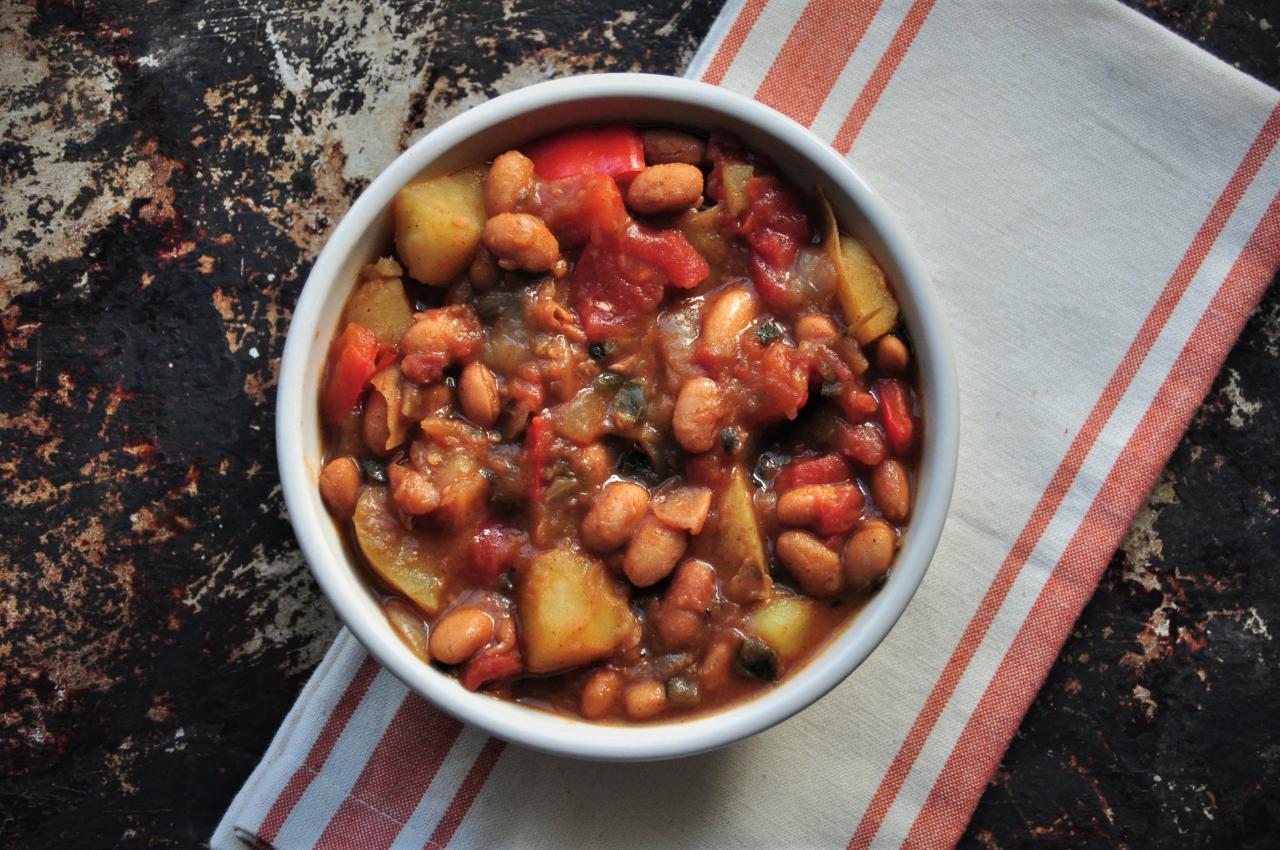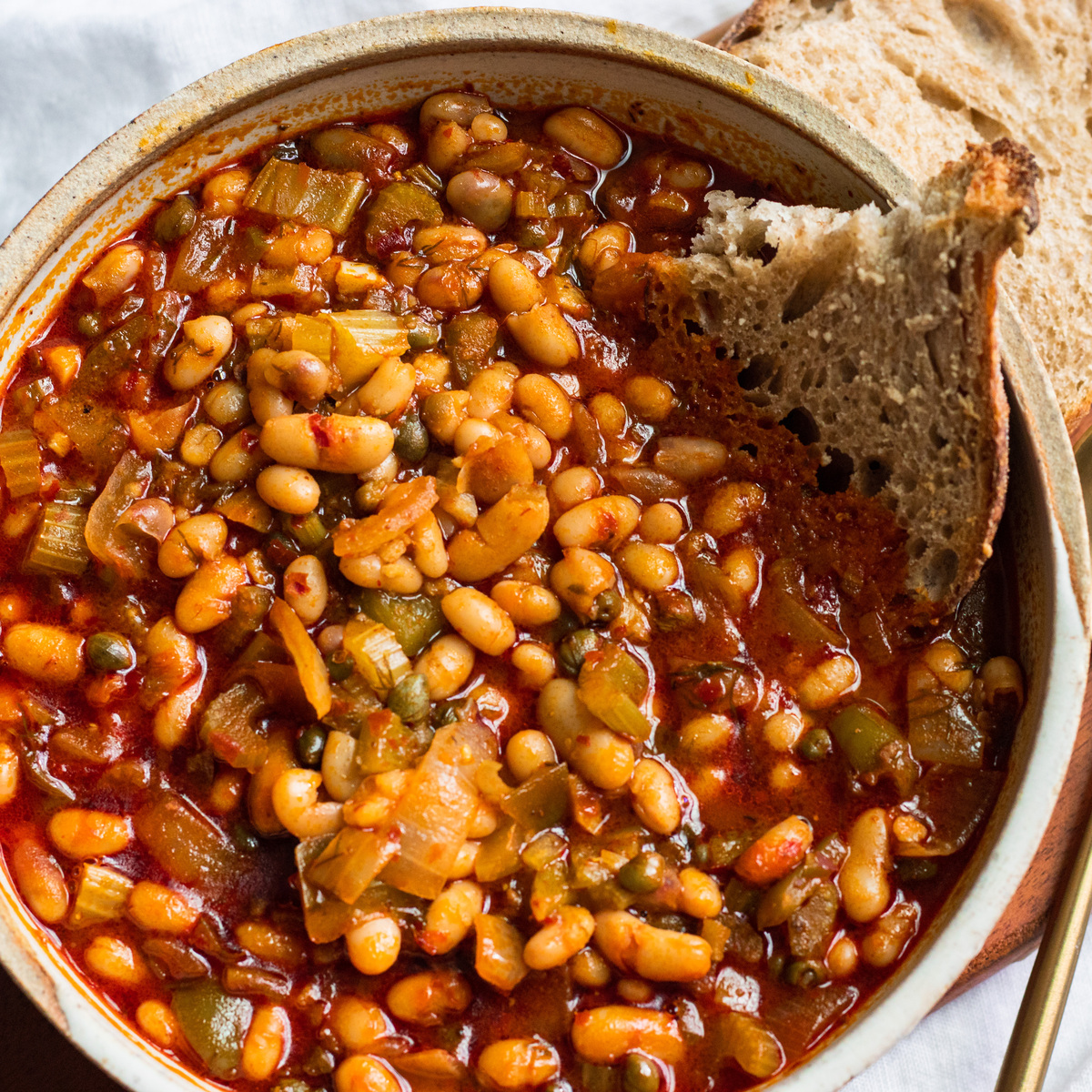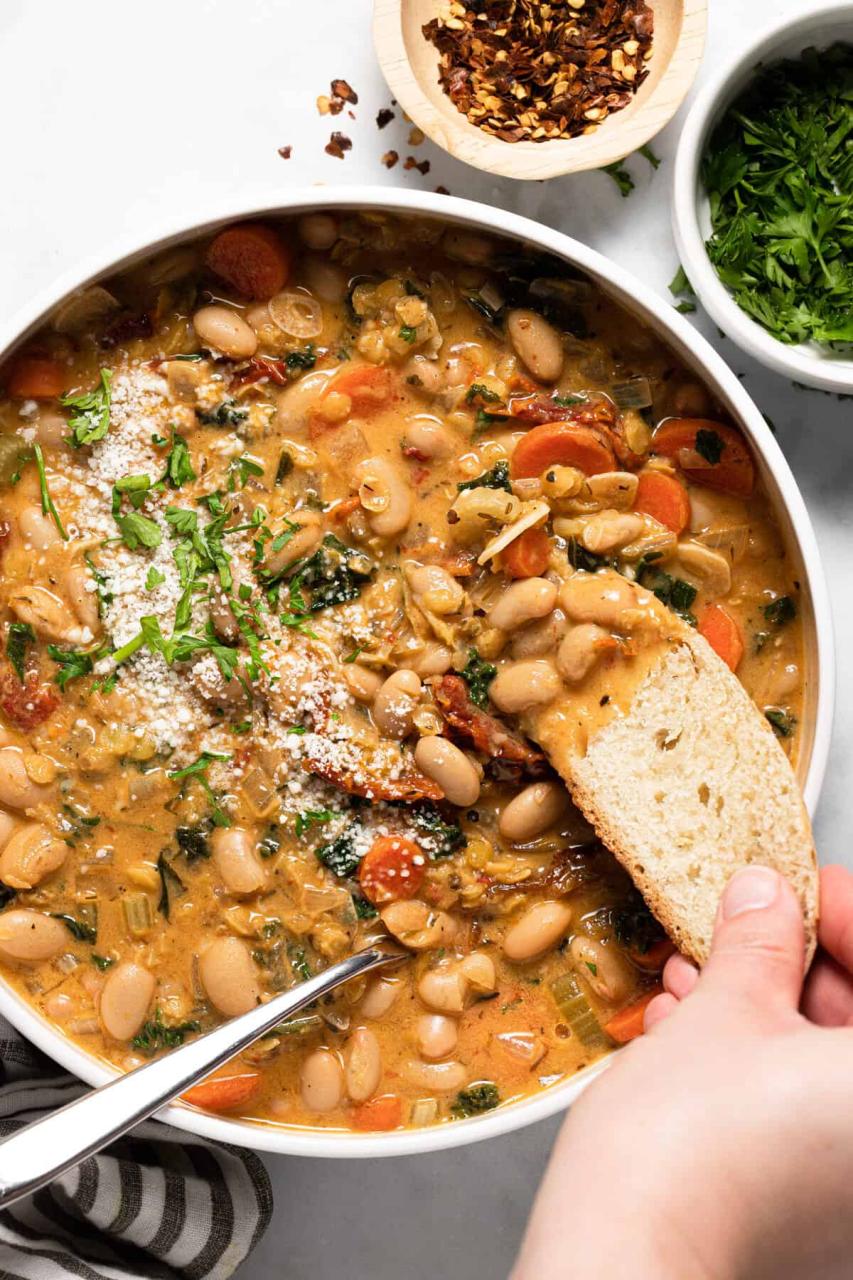Bean Stew is a hearty, nutritious, and versatile dish celebrated in kitchens around the globe for its comforting warmth and satisfying richness. At its core, Bean Stew combines various types of beans—ranging from black beans and kidney beans to pinto beans and chickpeas—with a medley of vegetables, herbs, and spices, simmered gently to allow the flavors to meld beautifully. This dish can be easily adapted to accommodate different tastes, dietary needs, and cultural preferences, making it a universal favorite.
Rich in protein, fiber, and essential nutrients while being naturally low in fat, Bean Stew serves not only as a staple food in many cultures but also as a powerful component of a balanced diet. It’s an embodiment of simplicity and nutrition, highlighting the humble bean’s ability to transform into a meal that comforts the soul and nourishes the body.
Whether enjoyed as a main course or as a side dish, Bean Stew can be customized with various ingredients such as tomatoes, onions, garlic, and leafy greens, or enhanced with meat, poultry, or seafood for added flavor. It’s a celebration of community and family, often shared around the table, providing warmth during the cold months and a filling, refreshing option throughout the year.
Bean Stew Recipe


Bean Stew
Equipment
- 1 pressure cooker
Ingredients
- 1 Tbsp. Olive oil
- 3 c. Water
- Pepper
- Salt
- 1/2 tsp. Cayenne pepper
- 1 Chopped tomato
- 1/2 tsp. Cumin seeds
- 1/2 tsp. Turmeric
- 1 tsp. Grated ginger
- 2 Chopped garlic cloves
- 1 Chopped onion
- 1 c. Mung beans
Instructions
- To begin with this recipe, bring out the pressure cooker and place the olive oil inside. Add the cumin seeds into this oil and cook for a bit. Add in the onion and let it become tender.
- Once those ingredients are cooked, add in the cayenne pepper, turmeric, ginger, and garlic and let it cook another 2 minutes.
- After that amount of time is done, add in a bit of water and the tomatoes. Allow the tomatoes to naturally release their juices before adding in the rest of the water and the beans and season this a bit.
- Place your lid over the pressure cooker and then allow the stew to cook a bit. Once the ingredients are all warmed up, allow the steam some time to release and then pour this into a bowl before serving.
Cooking tips about Bean Stew

- Choose Your Beans Wisely: Opt for a mix of beans for varied texture and flavor. Black beans, kidney beans, chickpeas, and pinto beans are all great choices. Remember to soak dried beans overnight to decrease cooking time and improve digestibility. Canned beans are a convenient alternative but rinse them well to reduce sodium levels.
- Build a Flavor Base: Start your stew with a sofrito – a blend of finely chopped onions, carrots, and celery sautéed in olive oil or another fat. This provides a rich flavor foundation. For depth, consider adding minced garlic and tomato paste as the mix cooks down.
- Use Quality Stock: Whether vegetable, chicken, or beef, a good-quality stock will significantly impact your stew’s overall flavor. Homemade stock is excellent, but there are also high-quality, low-sodium options available in stores.
- Herbs and Spices are Key: Fresh herbs like rosemary, thyme, and bay leaves add layers of flavor. Don’t shy away from spices either. Paprika, cumin, and coriander can introduce warmth and complexity. Adjust according to your taste preferences and don’t be afraid to experiment.
- Add Vegetables for More Nutrition: Besides the traditional carrots and celery, consider incorporating sweet potatoes, squash, or leafy greens like kale or spinach towards the end of cooking for added nutrients and color.
- The Right Time for Ingredients: Add ingredients based on their cooking times. Harder, root vegetables need more time, while softer vegetables and leafy greens should be added later to preserve their texture and nutritional value.
- Thicken for Richness: For a thicker stew, mash some beans and stir them back into the pot, or use a handheld blender to puree part of the stew lightly. This thickening technique adds body without altering the stew’s flavor.
- Rest Before Serving: Let your stew sit off the heat for 10 to 15 minutes before serving. This rest period allows flavors to meld together even more, making each bite richer and more cohesive.
- Taste and Season: Adjust salt, pepper, and acidity (with a splash of vinegar or squeeze of lemon) towards the end of cooking. These final touches can dramatically enhance the stew’s overall flavor profile.
- Serve Creatively: Beyond the bowl, bean stew can be served over rice, quinoa, or crusty bread. Garnishes like fresh herbs, a dollop of yogurt, avocado slices, or shredded cheese can add an extra layer of texture and flavor.
Serving suggestions about Bean Stew

- Over Grains: Serve your Bean Stew over a bed of cooked rice, quinoa, farro, or barley. These grains not only add an extra layer of texture but also absorb the stew’s flavors beautifully.
- With Crusty Bread: A slice of warm, crusty bread makes the perfect companion for Bean Stew. It’s ideal for soaking up the rich, flavorful broth.
- Polenta or Mashed Potatoes: For a comfort food twist, serve your Bean Stew over soft polenta or creamy mashed potatoes. The contrast between the hearty stew and the smooth base is truly satisfying.
- Garnishes for Texture and Flavor: Add a dollop of yogurt or sour cream, a sprinkle of grated cheese (like cheddar or Parmesan), fresh herbs (cilantro, parsley, or chives), avocado slices, or a squeeze of lime to brighten up the dish and add a layer of complexity.
- Tortillas on the Side: Warm tortillas, whether corn or flour, can be served on the side for scooping up the stew. This adds a hands-on, interactive element to the meal.
- Stuffed Vegetables: Hollow out bell peppers or zucchinis and fill them with your Bean Stew for a unique and visually appealing presentation.
- As a Taco Filling: Use the Bean Stew as a hearty filling for tacos. Garnish with lettuce, cheese, and salsa for a fun, customizable meal.
- Under a Blanket of Pastry: Top a baking dish filled with Bean Stew with a sheet of puff pastry or pie dough and bake until golden for a delicious bean pot pie.
- Layered in Jars: For a portable or picnic-friendly option, layer Bean Stew with rice and garnishes in mason jars. Not only does this make for a convenient meal, but it also looks enticing.
- Refreshing Salad Topper: In warmer months, serve your Bean Stew at room temperature over a crisp salad for a hearty yet refreshing meal.
Top 5 FAQs about Bean Stew

- What types of beans are best for making Bean Stew? For Bean Stew, a mix of beans is recommended to achieve varied texture and flavors. Black beans, kidney beans, chickpeas, and pinto beans are excellent choices. The use of dried beans, which should be soaked overnight, is encouraged for their texture and reduced cooking time, though canned beans serve as a convenient alternative.
- Can Bean Stew be customized for different dietary needs? Yes, Bean Stew is highly adaptable to various dietary preferences and restrictions. It can be made vegetarian or vegan by using vegetable stock and avoiding animal products. The inclusion of meats can enhance the flavor for non-vegetarian versions. Additionally, the stew can accommodate a range of vegetables, herbs, and spices tailored to individual tastes or dietary requirements.
- How can I thicken Bean Stew? To thicken Bean Stew, one method involves mashing some of the beans and stirring them back into the pot. Alternatively, you can lightly puree part of the stew using a handheld blender. This approach adds body and richness without altering the stew’s basic flavor profile.
- What are some serving suggestions for Bean Stew? Bean Stew can be served in many creative ways, such as over rice, quinoa, or alongside crusty bread. For a comforting twist, try serving it over soft polenta or mashed potatoes. Garnishes like fresh herbs, avocado slices, or a dollop of yogurt can add texture, flavor, and visual appeal.
- Is Bean Stew healthy? Bean Stew is celebrated for its nutritional value, providing a rich source of protein, fiber, and essential nutrients while being low in fat. It embodies wholesome cooking, making it a staple for both a balanced diet and comfort food repertoire. The addition of vegetables further enhances its nutritional profile, making it a hearty and nutritious option for any meal.
Leave a Reply